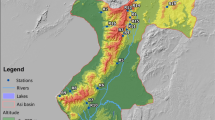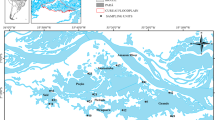Abstract
The performance of six diatom indices to evaluate water quality has been studied in the Artois-Picardie water basin. Results show that all of them satisfactorily assess organic pollution which is the main phenomenon responsible for the degradation of water quality throughout the year. However, only the Specific Pollution Sensitivity Index (SPI), the Generic Diatom Index (GDI) and the Commission of Economical Community Index (CEC) show significant correlations with the ionic strength (expressed by chlorides, sulphates and conductivity) and eutrophication (expressed by chlorophyll and nitrates). Diatom indices do not integrate chemical parameters in the same way. Best correlations are obtained through simultaneous or average chemical analyses whereas for other parameters, best correlations are noted with chemical analyses carried out just before diatom sampling. Tests performed on different chemical data sets show that it is possible to make a realistic estimation of water quality during the summer in the Artois-Picardie water basin by using SPI in September.
Similar content being viewed by others
References
Agence de l'Eau Artois-Picardie, 1992. Carte de qualité
Cemagref, 1982. Etude des méthodes biologiques quantitatives d'appréciation de la qualité des eaux. Rapport Division Qualité des Eaux Lyon - Agence de l'Eau Rhone - Méditerranée - Corse, Pierre - Bénite, 28 pp.
Coste, M. & H. Ayphasshorho, 1991. Etude de la quality des eaux du Bassin Artois-Picardie a l'aide des communautés de diatomées benthiques (Application des indices diatomiques). Rapport Cemagref Bordeaux -Agence de l'Eau Artois-Picardie, Douai, 227 pp.
Coste, M., C. Bosca & A. Dauta, 1991. Use of algae for monitoring rivers in France. In B.A. Whitton, E. Rott & G. Friedrich (eds), Use of algae for monitoring rivers. Düsseldorf, E. Rott, Innsbruck: 75–88.
Descy, J.P., 1979. A new approach to water quality estimation using diatoms. Nova Hedwigia 64: 305–323.
Descy, J.P. & M. Coste, 1991. A test of methods for assessing water quality based on diatoms. Verh. Internat. Verein. Limnol. 24: 2112–2116.
Krammer, K. & H. Lange-Bertalot, 1986–1991. Bacillariophyceae. Süsswasserflora von Mitteleuropa. 2(1–4). G. Fischer, Stuttgart.
Leclercq, L. & Maquet B., 1987. Deux nouveaux indices chimique et diatomique de quality d'eau courante. Application au Samson et a ses affluents (bassin de la Meuse belge). Comparaison avec d'autres indices chimiques, biocénotiques et diatomiques. Institut Royal des Sciences Naturelles de Belgique, document de travail 28, 113 pp.
Lange-Bertalot, H., 1979. Pollution tolerance of diatoms as a criterion for water quality estimation. Nova Hedwigia 64: 285–304.
Lecointe, C., M. Coste & J. Prygiel, 1993. “Omnidia”: software for taxonomy, calculation of diatom indices and inventories management. Hydrobiologia 269/270: 509–513.
Patrick, R., 1949. A proposed biological measure of stream conditions based on a survey of the Conestoga basin, Lancaster country, Pennsylviana. Proc. Acad. nat. Sci. Philad. 101: 277–341.
Prygiel, J., 1991. Use of benthic diatoms in surveillance of the Artois-Picardie basin hydrobiological quality. In B.A. Whitton, E. Rott & G. Friedrich (eds), Use of algae for monitoring rivers, Düsseldorf, E. Rott, Innsbruck: 89–96.
Round, F.E., R. Crawford & D. Mann, 1990. The diatoms. Cambridge University Press, Cambridge, 747 pp.
Sabater, S., F. Sabater & X. Thomas, 1987. Water quality and diatom communities in two Catalan rivers. Water Res. 21, 8: 901–911.
Schoeman, F.R., F. Haworth & E. Haworth, 1986. Diatoms as indicators of pollution. Report on a workshop. In M. Ricard (ed.), Proceedings of the 8th International Diatom Symposium. O. Koeltz Publishing, Koenigstein: 757–759.
Sládeček, V., 1986. Diatoms as indicators of organic pollution. Acta Hydrochim. Hydrobiol. 14: 555–566.
Ter Braak, C.J.F. & H. Van Dam, 1989. Inferring pH from diatoms: a comparison of old and new calibration methods. Hydrobiologia 178: 209–223.
Van Dam H., 1982. On the use of measures of structure and diversity in applied diatom ecology. Nova Hedwigia 73: 97–115.
Vanlandingham, S.L., 1976. Comparative evaluation of water quality of the St.Joseph river (Michigan and Indiana, USA) by three methods of algal analysis. Hydrobiologia 48: 145–173.
Zelinka, M. & P. Marvan, 1961. Zur Präzisierung der biologischen Klassifikation des Rheinheit Fliessender Gewässer. Archiv. Hydrobiol. 57: 389–407.
Author information
Authors and Affiliations
Rights and permissions
About this article
Cite this article
Prygiel, J., Coste, M. The assessment of water quality in the Artois-Picardie water basin (France) by the use of diatom indices. Hydrobiologia 269, 343–349 (1993). https://doi.org/10.1007/BF00028033
Issue Date:
DOI: https://doi.org/10.1007/BF00028033




